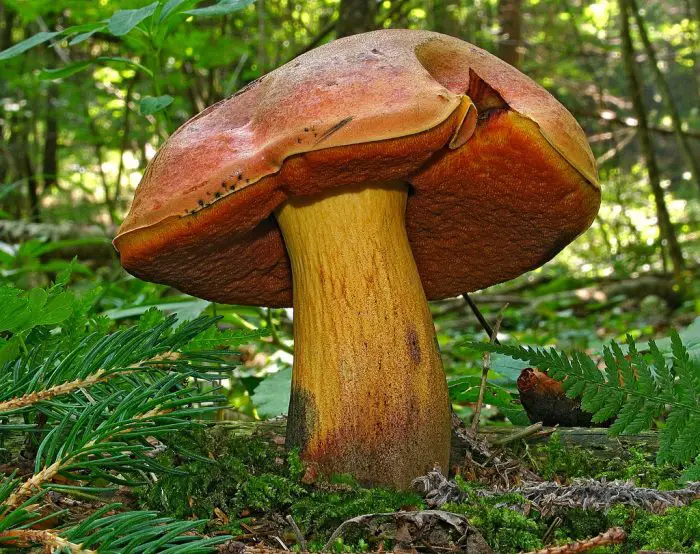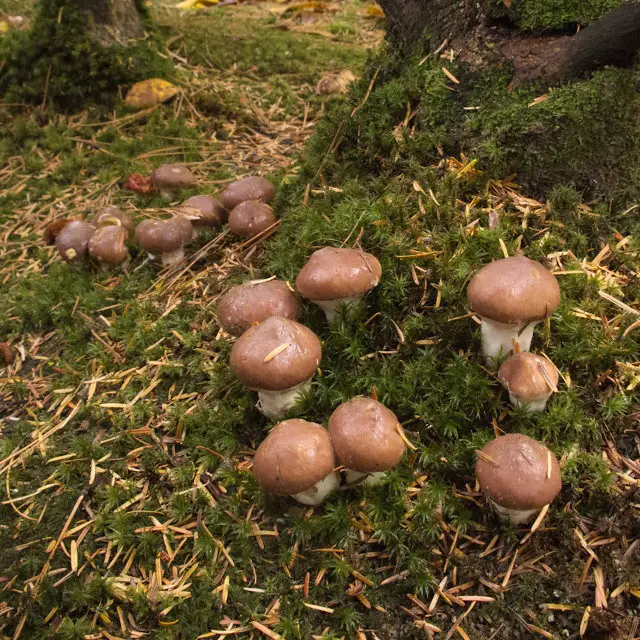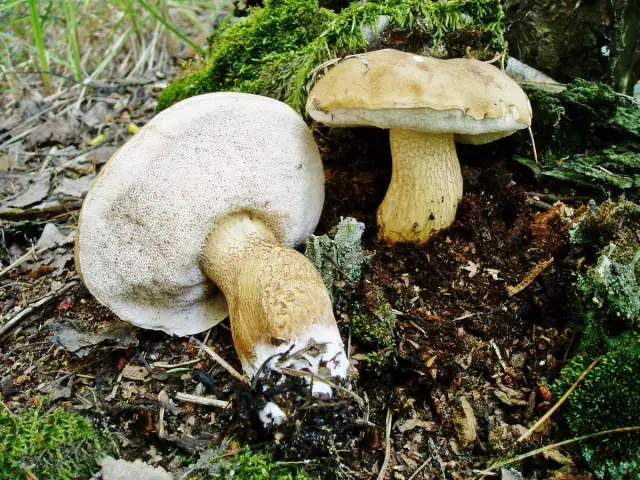When drawing mushrooms, children usually use brown paints. And this is no accident. Among the wide variety of shades of color of mushroom fruits, the advantage remains with the brown color. Let discuss Types of brown mushrooms with cap and stem.

Table of Contents
Areas of growth of brown mushrooms
Each mushroom species has its own requirements for soil composition, lighting, moisture conditions. They also bear fruit at different times. Information about the growing places and fruiting times of edible brown mushrooms is presented in the following table:
| Species name | Growing places | Terrain features | Fruiting period | Geography of distribution |
|---|---|---|---|---|
| White mushroom | conifers, deciduous stands, birch and oak groves, under pine forests | mosses, lichens under coniferous and deciduous trees | June-September | cosmopolitan |
| oak mushroom, Boletus luridus | deciduous and mixed forests | under oak, linden | June; Aug. Sept | ubiquitous |
| Motley moss | deciduous forest plantations | loose soils, mainly under beeches | June-October | European part of Russia, Caucasus, Far East |
| Honey mushrooms | forests of any type | stumps, dead and weakened wood | june-january | ubiquitous |
| Chanterelle | woodlands of different types | moss, scorched foliage | June-October | ubiquitous |
| Boletus | aspen forests, deciduous and coniferous forests, birch groves | usually creates mycorrhiza with hardwoods | early summer – late autumn | Mainly in the European part and in the Far East |
| Milk lover | deciduous, coniferous and mixed forests | damp terrain | August-October | everywhere, but rarely, singly or in small groups |
| Butterlets | coniferous plantations | under double and five-coniferous species of pines and larch | mostly in August | ubiquitous |
| Valui | birch forests, mixed forests | wet shady places | midsummer – October | European part, Western Siberia, Caucasus, Far East |
| Colibia oil | predominantly coniferous forests | fallen needles | July-November | ubiquitous |
| Spruce moss | forests with spruce trees | forest floor, moss, heather | late summer – first frosts | northern, central Russia |
| Edible raincoat | predominantly deciduous forests, gardens, parks | rotten wood | mid summer-early autumn | wide distribution area, practically cosmopolitan |
| Greenfinch | coniferous forests | next to gray rows | all autumn | ubiquitous |
| Lepiota corymbose | deciduous and coniferous forests | fallen needles and leaves | autumn | rare view |
| Pecica dark chestnut | coniferous and mixed types of forest plantations | deadwood, deciduous litter | May-September | wide distribution area |
The fruiting period of the mycelium largely depends on the weather and climatic conditions of the region as a whole. In different parts of the country, the same mushroom species can produce crops at different times.
Check out a guide on Varieties of Mushrooms that Grow in Grass.
Edible Types of brown mushrooms with cap and stem
There are several mushroom varieties with brown fruit color. Most often, different shades of this color express the colors of both the hats and the legs.

White mushroom
Large fruits with convex or flat-convex velvet caps and massive barrel-shaped legs. A distinctive feature of the porcini mushroom is the unique pattern at the bottom of the fruit.
The leg is decorated with a white mesh of veins. A tubular spore layer is located under the cap. The flesh of the porcini mushroom is strong, juicy. When heat-treated, it exhibits a rich mushroom smell.
oak mushroom, Boletus luridus
Massive fruits with hemispherical or cushion velvet caps on a thick stem with a dark mesh pattern. A row of narrow tubes is located between the cap and the leg of the oak tree. Depending on the age of the fetus, they change from ocher to red-orange. And the tubular layer of ripe mushrooms is expressed with a dark olive tint.
Motley moss
The fruits are medium-sized. The cap of the flywheel is fleshy, and convex. Its felt surface is often covered with reddish cracks. In some specimens, the edge of the cap may be bordered with a purple stripe. The leg is solid, cylindrical, narrowing towards the bottom. Its base is colored red. When you press on the leg or tubules, the damage site turns blue.
Honey mushrooms
Several varieties of honey agarics are colored brown at once:
- autumn;
- winter;
- fat-legged;
- dark;
- shrinking.
Each species has its own individual external characteristics. The surface of the caps of all edible mushrooms is rough to the touch. Young mushrooms have a ring on their stem. The spore layer is represented by plates of a predominantly creamy shade. A pleasant mushroom aroma emanates from the flesh of the edible varieties.
Chanterelle
The fruiting body is represented by a funnel-shaped cap, smoothly turning into a shortened stalk. The hymenophore is expressed by a number of plates. The reddish-brown color is characteristic of the common chanterelle species. The pulp of this mushroom has excellent taste and a pleasant aroma.
Boletus
The fruits of such varieties of boletus are colored brown:
- Red;
- yellow-brown;
- oak;
- pine;
- painted-legged.
The mushrooms grow large. The main distinguishing feature of boletus is considered to be a light thickened leg, covered with many dark scales. The pulp turns blue when pressed. The fruit emits a strong but pleasant smell.
Milk lover
The lactus is red-brown, smooth or euphorbia has medium-sized fruits with fleshy caps on a strong velvety stem. The spore layer is represented by a series of narrow but fleshy light plates, which are covered with brown spots at the point of pressure.
The flesh is firm, sweet, colored white. In young fruits, it smells nice, and the smell of old milk mushrooms evokes associations with herring and crabs. At the break, the pulp gives abundant and sticky milky juice, which in the air changes its color from white to grayish-brown.
Butterlets
Small mushrooms with various cap shapes – from convex to flattened. The surface of the oiler is practically never dry. It is always slippery or sticky, depending on the weather conditions. The mushroom leg is solid. In some varieties, it is decorated with a mushroom ring. The pulp is light, at the cut site it can take on a bluish or reddish tint.
Valui
With age, the spherical caps of young Valuev transform into flattened ones with a pronounced depression in the central zone and radial grooves along the edges. The surface is smooth and slimy. The leg is white, often covered with brown spots. A yellowish transparent liquid is released from the valuy plates. The white pulp turns brown on the cut, has a burning aftertaste.
Colibia oil
Small fruits with convex, broadly convex or flattened hygrophane caps. The leg is long, thin, with an absolutely smooth surface. The lamellar hymenophore is whitish-pinkish. The pulp is white, watery. The taste and smell are weak.
Spruce moss
Popularly, this species is known as a slug. The shape of the cap changes depending on the age of the mushroom. Initially, it is hemispherical with rolled edges. Then the hat is transformed into a convex-conical one, and then into an open one with a small depression in the center.
There is a black speck on the surface of the caps of old worms. In young fruits, you can see the remnants of a mushroom blanket. The leg is massive, swollen, its upper part is surrounded by a slimy mushroom ring. The pulp of spruce moss has a sweet and sour taste and a weak mushroom aroma.
Edible raincoat
Another name – a pear-shaped raincoat – this species received for the peculiar shape of the fruiting body, which resembles a large pear. Only old mushrooms are brown. Young raincoats are white and covered with frequent thorn-like growths. Over time, the color changes, acquiring brown-brown shades, and the thorns disappear.
Greenfinch
Synonyms – green ryadovka, brilliant green. The greenfinch hat acquires a brownish tint with age. Young mushrooms are distinguished by their green color, which is not lost even after heat treatment. The pulp of the mushrooms has a flour smell characteristic of all the rows. Greenfinch’s taste is not pronounced.
Lepiota corymbose
Other names are thyroid or small thyroid umbel. The bell-shaped cap transforms into a flattened cap with age. The brown tint is given to it by a layer of small scales, which stand out well against the background of the white pulp of the lepiota.
Flaps hang unevenly at the edges of the cap. The stem is thin, with a velvety surface and a disappearing flocculent ring. The flesh of the lepiota is white, sweet, and smells good of fruit.
Pecica dark chestnut
The mushroom has an unusual shape. Its initially spherical body over time takes on a shape that resembles a rounded bowl or saucer. The thin flesh of the pecitsa is colored with a brownish color. It is very brittle, without a pronounced taste and smell.
People want to know about Trees under which Mushrooms Grow with names and pictures.
Poisonous types of brown mushrooms
The brown color is also typical for inedible species. Moreover, some of them are toxic.

Gall mushroom (gorchak)
The most famous double of the noble porcini mushroom.
The following features are considered to be the distinctive features of the species:
- dark mesh pattern on a mushroom leg;
- spongy hymenophore turning pink over time;
- flesh turning brown at the break.
Gorchak is inedible.
Galerina bordered
A highly poisonous mushroom. Its toxicity is comparable to that of the pale toadstool and the red fly agaric. Galerina is easy to confuse with some types of honey agarics. It is especially similar to the summer mushroom. There are no clear distinguishing features of the difference between these mushrooms.
The only way to protect yourself is to limit the territory of the search for mushrooms, since the bordered gallery grows exclusively in coniferous forests. Therefore, it is better to go to the gathering of honey agarics in the massifs with deciduous tree species.
Smelly raincoat
The inedible look can be confused with edible raincoats. A distinctive feature of the smelly variety is the smell of its fruits. The flesh of the inedible mushroom emits an unpleasant odor, somewhat reminiscent of light gas.
Pepper mushroom
Inedible counterpart of some mushrooms and butter. The mushroom is not poisonous, but it is not suitable for eating because of the very bitter pulp. However, some mushroom pickers use it to prepare mushroom spices.
Light ocher webcap
This species belongs to the poisonous category of mushrooms. A young spider web is very similar to the fruit of the porcini mushroom. The species can be distinguished by the characteristics of the hymenophore. In the cobweb, it is expressed in plates, and in the noble boletus – in tubules.
Comb umbrella
Twin of corymbose lepiota. You can distinguish a false mushroom by the following features:
- the presence of scales on the cap that form a scallop;
- flesh reddening from damage;
- unpleasant smell of rotten garlic.
The comb umbrella is poisonous.
False foam watery
Inedible mushroom. Only an inexperienced mushroom picker can confuse it with brown mushrooms. It is difficult to call similar species, since the false froth has a different shape of the fetus, geography of distribution and many other features.
Tips from experienced mushroom pickers
Experienced mushroom pickers recommend that you go on your first hikes only when accompanied by knowledgeable people. The appearance of mushrooms is characterized by variability. Almost all species change color, shape, surface type as they develop.
Advice! The mushrooms should be cut, not broken. This will preserve the integrity of the mycelium, as a result of which new fruits will soon grow in the same place.
Fees can only be carried out in ecologically clean areas. The fungal body, like a sponge, tends to absorb substances from the environment, including toxic ones. As a result, even an edible mushroom can be poisonous if it grows in a polluted area.
The brown color can be found not only in edible mushrooms. It is also common in inedible and venomous species. Therefore, the determination by the color of the fruit cannot be a decisive sign of edibility.